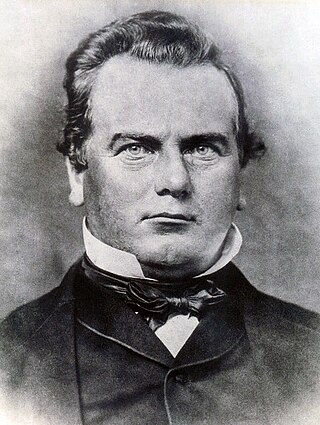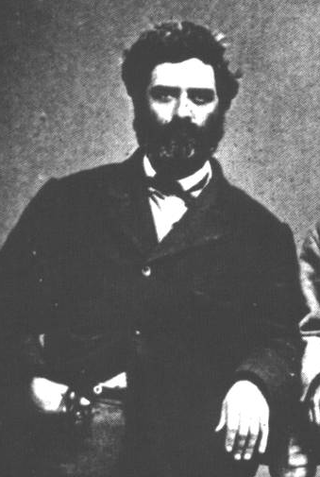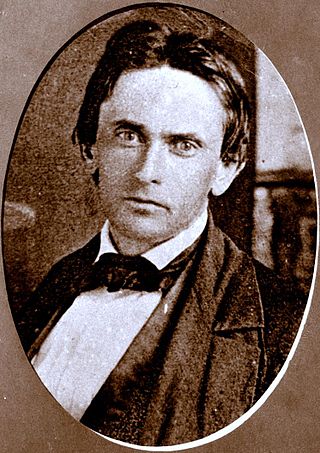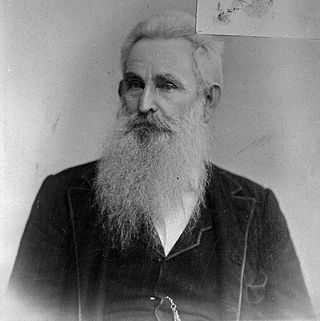Related Research Articles

Phineas Banning was an American businessman,financier and entrepreneur.

Cameron Erskine Thom was a lawyer,a legislator,a Confederate officer in the Civil War,and the 16th mayor of Los Angeles from 1882 to 1884.

Charles Hathaway Larrabee was an American lawyer and Democratic politician from Dodge County,Wisconsin. He served one term in the U.S. House of Representatives,representing Wisconsin's 3rd congressional district during the 36th Congress (1859–1860),and was an ex officio member of Wisconsin's first state Supreme Court (1848–1953) due to his role as one of Wisconsin's first elected circuit court judges. He also served as a Union Army officer during the American Civil War.

The history of newspapers in California dates back to 1846,with the first publication of The Californian in Monterey. Since then California has been served by a large number of newspapers based in many cities.

Tomas Avila Sanchez (1826–1882),soldier,sheriff and public official,was on the Los Angeles County,California,Board of Supervisors and was a member of the Los Angeles Common Council,the legislative branch of the city.

Benjamin Hayes, or Benjamin Ignatius Hayes, (1815–1877) was an American pioneer who was the first judge of the district court that served Los Angeles,San Diego and San Bernardino counties in California. His seminal rulings are still cited in that state's courts.

Bethel Coopwood (1827–1907) was born in Alabama,and moved to Texas and was a soldier in the Mexican–American War and an officer in the Confederate Army in the American Civil War. He was a lawyer,judge,and later a historian.

Ezra Drown was an attorney who escaped a shipwreck to become the district attorney of Los Angeles County,California,in 1857–59 and 1861–63 and a member of the Los Angeles Common Council,the governing body of the city of Los Angeles,in 1859 and 1861.

The California Digital Newspaper Collection (CDNC) is a freely-available,archive of digitized California newspapers;it is accessible through the project's website. The collection contains over six million pages from over forty-two million articles. The project is part of the Center for Bibliographical Studies and Research (CBSR) at the University of California Riverside.

Frederick Alonzo Bee (傅列秘) was an early opponent of Anti-Chinese sentiment in the United States. He was a California Gold Rush pioneer,miner,merchant,manager of the Pony Express,builder of the telegraph over the Sierras,developer of Sausalito,California,lobbyist for the San Francisco Chamber of Commerce,official at the Chinese Consulate,and vineyardist near Martinez,California. Bee Street in Sausalito was named after him. Bee was appointed as Consul by the Chinese government after he effectively represented the interests of the Chinese community in front of a Congressional committee and settled disputes in Chinatown. Bee acted in an official capacity to represent the interests of Chinese immigrants,and appeared in federal court cases;his efforts to preserve harmony were recognized by the Emperor of China. October,2015 Sierra Heritage magazine featured Frederick Bee in a 4-page article written by Lj Bottjer. Sherri Bergmann wrote an article for the January 22,2018,Mountain Democrat.
The California Steam Navigation Company was formed in 1854 to consolidate competing steamship companies in the San Francisco Bay Area and on the Sacramento and San Joaquin Rivers. It was successful in this effort and established a profitable near-monopoly which it maintained by buying out or bankrupting new competitors. In response to the Fraser Canyon gold rush and economic growth in the Pacific Northwest,the company expanded to ocean routes from San Francisco north to British Columbia. Similarly,as California's economy grew,the company offered service from San Francisco south to San Pedro and San Diego. It exited these markets in 1867 when competition drove prices to unprofitable levels. While the California Steam Navigation Company was successful throughout its life in suppressing steamboat competition on its core Bay Area and river routes,it could not control the rise of railroads. These new competitors reduced the company's revenue and profit. Finally,in 1871,the company's assets were purchased by the California Pacific Railroad,and the corporation was dissolved.
Samuel F. Reynolds was a Los Angeles City Attorney and a judge in 19th century California. He was also active in the International Order of Odd Fellows.
Hemen "H. C." Cardwell was a pioneer settler in California who served in the Mexican–American War,served as Zanjero of Los Angeles,was a major contributor to early California business and agriculture,and served in the first California State Assembly in 1849–1850.

Henry Oscar Beatty,generally known as H. O. Beatty,was an American lawyer and jurist who served as a justice of the Supreme Court of Nevada from 1864 to 1868,and who was a leading societal figure in Sacramento,California.
The Round Valley Settler Massacres of 1856–1859 were a series of massacres committed by early white settlers of California with cooperation and funding from the government of California and the support of prominent Californians against the Yuki people of Round Valley,Mendocino County,California. More than 1,000 Yuki are estimated to have been killed;many others were enslaved and only 300 survived. The intent of the massacres was to exterminate the Yuki and gain control of the land they inhabited. U.S. Army soldiers deployed to the valley stopped most of the killings and in 1862 the California legislature revoked a law which permitted the kidnapping and enslavement of Native Americans in the state.

Rowena Granice Steele was an American performer,author of poetry and novels,as well as a newspaper journalist,editor,and publisher. The first novel written by a woman in California was Steele's,The Victims of Fate,a work of fiction loosely based on David C. Broderick,the preface stating:"Some of the incidents of this little story,are real facts. I had the honor of being acquainted with the hero,from my earliest childhood. First as a lad of little promise,although to use a quaint expression,King-Bee among his boy companions. After,as a young,terprising aspirant for political fame. Last,as the finished gentleman and a nation's pride." Steele was well known for the entertainments which she provided during the early days of the California Gold Rush,where,with her son,George,she acted out scenes from Shakespeare and bits of comedy. Steele died in 1901.
The California State Telegraph Company was a business originally organized to provide telegraph service between San Francisco and Marysville,California. By the spring of 1861,the company had expanded its service area south to Los Angeles,north to Yreka,and east to Fort Churchill by absorbing the other telegraph companies in California. In 1861,the company formed the Overland Telegraph Company,which was responsible for constructing part of the telegraph line which resulted in the first transcontinental telegraph network in the United States.
References
- ↑ Chronological Record of Los Angeles City Officials,1850-1938, compiled under direction of Municipal Reference Library, City Hall, Los Angeles (March 1938, reprinted 1966). "Prepared ... as a report on Project No. SA 3123-5703-6077-8121-9900 conducted under the auspices of the Works Progress Administration."
- ↑ Political Graveyard
- ↑ California State Library; Sacramento, California; Great Registers, 1866-1898; Collection Number: 4-2A; CSL Roll Number: 27; FHL Roll Number: 976939
- ↑ "Case of 'Cherokee Bob,'" Los Angeles Star, January 12, 1856, page 2
- ↑ Los Angeles Star, October 13, 1857, quoted at Mountain Meadows, University of Nebraska, Lincoln
- ↑ J.M. Scammell, "Military Units in Southern California, 1853–1862," California Historical Society Quarterly, vol. 29, no. 3
- ↑ "San Bernardino," The (Sacramento) Daily Bee, September 26, 1861, page 3
- ↑ "Military Matters in the State," Daily National Democrat, Marysville, September 29, 1861, page 3
- ↑ Quoted in "Silver Bullets," The Sonoma County Journal, October 26, 1860, page 4
- ↑ "Legislative," The Daily Bee, Sacramento, February 15, 1868, page 2